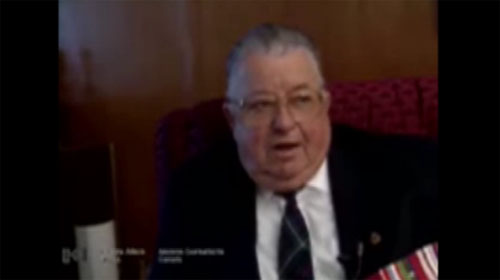Shoe Mines and S-Mines
Heroes Remember
Shoe Mines and S-Mines
Transcript
Description
When the German’s were retreating from a position the only thing they left behind were mines. Smokey tells us about two types of mines they used.
Ernest “Smokey” Smith
Ernest “Smokey” Smith VC, CD, was born in New Westminster, British Columbia, on May 3, 1914, and was educated in elementary and technical schools there. He was the second of five children having an older sister, two younger brothers and a younger sister. Both brothers served in and survived the Second World War. Smokey left his work with a contracting firm to enlist with the Seaforth Highlanders of Canada in March of 1940 and began basic training with the Royal Canadian Regiment in Toronto. He went on to complete his training at Camp Borden before sailing out of Halifax in June of that same year on the Monarcher of Bermuda, heading for Europe and joining the regiment overseas a few months later. Smokey was injured while fighting in Sicily, but returned to battle a few months later in Italy. He was a private when he won the Victoria Cross, Canada's highest award for valour, at the Savio River in Italy on October 21-22, 1944. After the war, Smokey left the Army for a short time, but rejoined and served until August 1964, when he retired and was released with the rank of sergeant. After leaving the military Smokey and his wife established the Smith Travel Agency in Vancouver. In 1995, Smokey was appointed to the Order of Canada. At the time of his death on Aug. 5, 2005 Smokey Smith was the last surviving Canadian recipient of the Victoria Cross.
Meta Data
- Medium:
- Video
- Owner:
- Veterans Affairs Canada
- Duration:
- 01:16
- Person Interviewed:
- Ernest “Smokey” Smith
- War, Conflict or Mission:
- Second World War
- Location/Theatre:
- Italy
- Battle/Campaign:
- Italian
- Branch:
- Army
- Units/Ship:
- Seaforth Highlanders
- Rank:
- Private
Related Videos
- Date modified:




